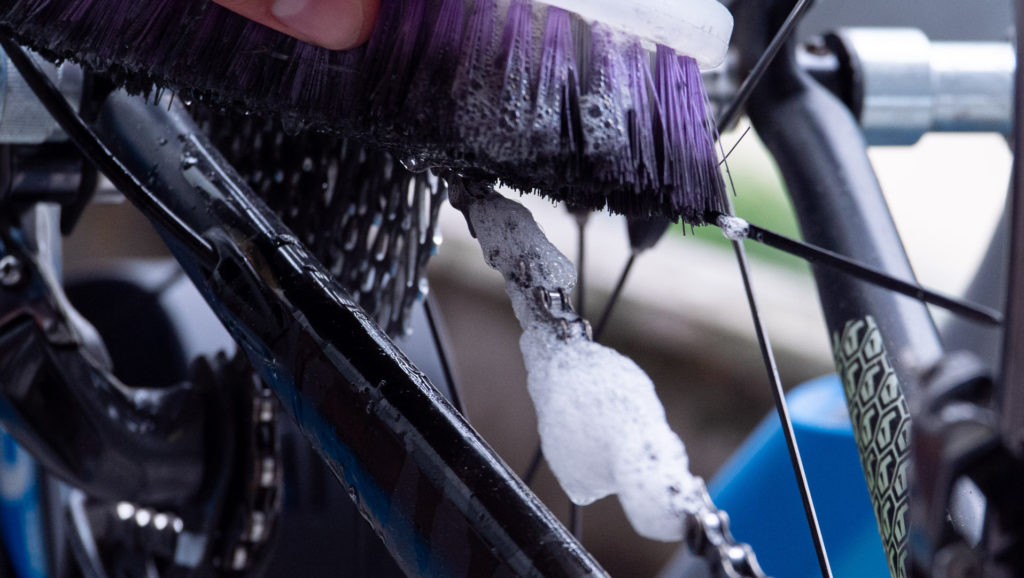Info: In diesem Beitrag wurden die Produkte selbst erworben, eine Kooperation mit Herstellern erfolgt nicht. Erfahrt mehr über Werbung auf Velonerd.cc.
Wear eats bicycle chains for breakfast. The most flexible and frequently changed wearing part (just after the inner tube) is the chain. It rusts, squeaks and stretches. But if you take care, you can increase a mileage of only 1,000 – 2,000km up to 5,000km and beyond. And save yourself a good bit of more than one replacement part a year. We show you how to maintain it optimally for the perfect running performance.
Not to mention all the power that is uselessly converted into friction. Which is what happens when the chain is rusty, gunky and makes noise. Especially who is looking for best performance (hint: road bikes) should devote much love to the chain.
Lubricants and detergents
First of all, let’s clear up the basics of chain maintenance. Lubrication and cleaning are the be-all and end-all. This may sound obvious, but it should always be remembered: You can’t lubricate and clean at the same time. We do not recommend miracle products that promise to lubricate and clean at the same time.
Also, you should not aim for an all-time effect. In fact, the chain must also be cleaned about once a month with frequent use (even up to 1x a week, or after every single ride for enthusiasts). Those who drive more frequently should plan these cycles even more closely. Time permitting – but do you want to clean it shortly on every ride or deeply but not as often? Its up to your schedule. Any way you decide – it pays off! On many levels (efficiency, friction, maintenance and wear).
A lubricated chain is necessarily also a greasy chain.
Why do these two processes Cleaning and Greasing categorically excluded?
Quite simply, it is the lubricating film of the chain that simultaneously ensures the smooth running of the chain and, on the other hand, attracts the dirt that sticks and gets stuck on the lubricating film. A lubricated chain is necessarily also a greasy chain. This means that all effective cleaning agents also attack the lubricating film of the chain at the same time, dissolve the chain oils or dilute them.
This follows: After you have applied a cleaning agent on the chain, it is urgently necessary to apply a new lubricating film (by new grease/oil/wax) afterwards!
Optionally, superficial cleaning is always possible and useful. However, it depends on whether you are attacking the existing oil film or actually removing only superficial contamination.
But manufacturers often write that their product cleans and lubricates at the same time? Isn’t that right?
Quite some oils have self-cleaning properties. Means by the friction dirt particles are “thrown off” in motion. While this is possible and true in theory, some agents actually stay clean longer than others. However, this has nothing to do with the proper care and cleaning of the chain.
On the subject of oiling and greasing the chain, we have written the following separate instructions. When you’re done cleaning, think about greasing!
New chains – apply cleaning agent as late as possible or not at all
That’s why you should also wait as long as possible to apply a cleaning agent when you have a new bike or chain. For optimum longevity, maintain the original oiling for as long as possible. This is because when applying a new chain oil, practically only the outer lubricating film can be restored. The oiling between the rollers is difficult to replace again – to bring a chain back to industry standard even after prolonged use, you would have to disassemble it into all its individual parts and oil them individually. However, that would be highly impractical.
Some cyclists even advise not to use chemical cleaners at all. You should leave it on a mechanical cleaning, that is: remove the dirt particles with a washcloth or a chain brush (or an old toothbrush). However, we think that the use of detergents on the bicycle chain already has its purpose: you should be extremely careful and use the detergent only in small measures!
Finally, however, the following also applies: the quantity makes the poison. And those who are already poisoned should go all out. Means: if you already make a “deep cleaning”, with various agents and cleaners which dissolve the inner oil film, then take extra time to let new oil act.
Bicycle chain cleaner – Tips
- Rather, maintain the chain more frequently and always apply a little to no oil instead of infrequently and a lot – this is better than any cleaner.
- Cleans the bicycle chain with a rag, toothbrush or brush specially designed for this purpose – mechanical cleaning does not destroy the internal lubricating film of the chain. As a result, the chain has a longer service life.
- Should you use a cleaner (anything that dissolves grease, i.e. dishwashing liquid, WD40 or a special chain cleaner), the life of this chain will be short. This cleaning is the last resort when the chain already carries rust or the links are already becoming stiff. Try to think of this only as a last resort.
In the following table you can see which cleaning level is appropriate.
| Verschmutzung | Reinigung | Schmierung |
|---|---|---|
| Leichte Verschmutzung und relativ neue Kette; keine Geräusche | Mit dem Lappen oder Papiertuch abwischen bis die Kette oberflächlich sauber ist (keinen Schmutz auf Fingern hinterlässt) | Kein neues Öl auftragen |
| Deutlich sichtbare Verschmutzung; keine Geräusche; Häufig genutztes Rad (auch im Regen) | Mit dem Lappen oder Papiertuch abwischen bis die Kette oberflächlich sauber ist (keinen Schmutz auf Fingern hinterlässt); Reinigungsmittel nur auf Lappen oder Papiertuch auftragen um nur oberflächlichen Ölfilm zu entfernen; | Kein neues Öl auftragen oder nur sparsam Öl auftragen |
| Deutlich sichtbare Verschmutzung; Kette quietscht; Leichte oberflächliche Roststellen | Reinigungsmittel nur auf Lappen oder Papiertuch auftragen um nur oberflächlichen Ölfilm zu entfernen; Stellenweise Reinigungsmittel direkt auf Kette auftragen, wenn Roststelle sichtbar; | Sparsam neues Öl auftragen; Danach unbedingt Reste von der Kette abwischen |
| Starke Verschmutzung; Kette quietscht; Roststellen | Reinigungsmittel direkt auf die Kette geben und Kette stark bearbeiten bis sie wieder sauber ist und keinen Rost mehr hat; | Tiefergehende Schmierung, einwirken lassen und gründlich überschüssiges Öl abwischen; Siehe auch Anleitung und Tipps im Detail zum Fahrradkette Schmieren |
Grease dissolving or gentle
Cleaning agents for the chain can generally be divided into two camps:
- grease-dissolving cleaners: attack the existing lubrication of the chain
- non-grease dissolving cleaners: maintain the existing lubrication of the chain
It is recommended to have two different cleaners at home for cleaning. As light a cleaner as possible to put on the rag for a “quick inspection”. The chain is cleaned only mechanically and superficially. The lubrication is maintained.
And a deeper/grease-dissolving cleaner to pack out for tough cases. WD-40 or another stronger cleaner can also be used for this purpose.
Which means to take chain care?
Now the question arises: Which cleaning agent do I use? Which lubricant do I use? There are various agents circulating on the market. We provide an overview. In the further course of this article, we also clarify controversial topics such as WD-40.
Detergent – bicycle chain cleaner
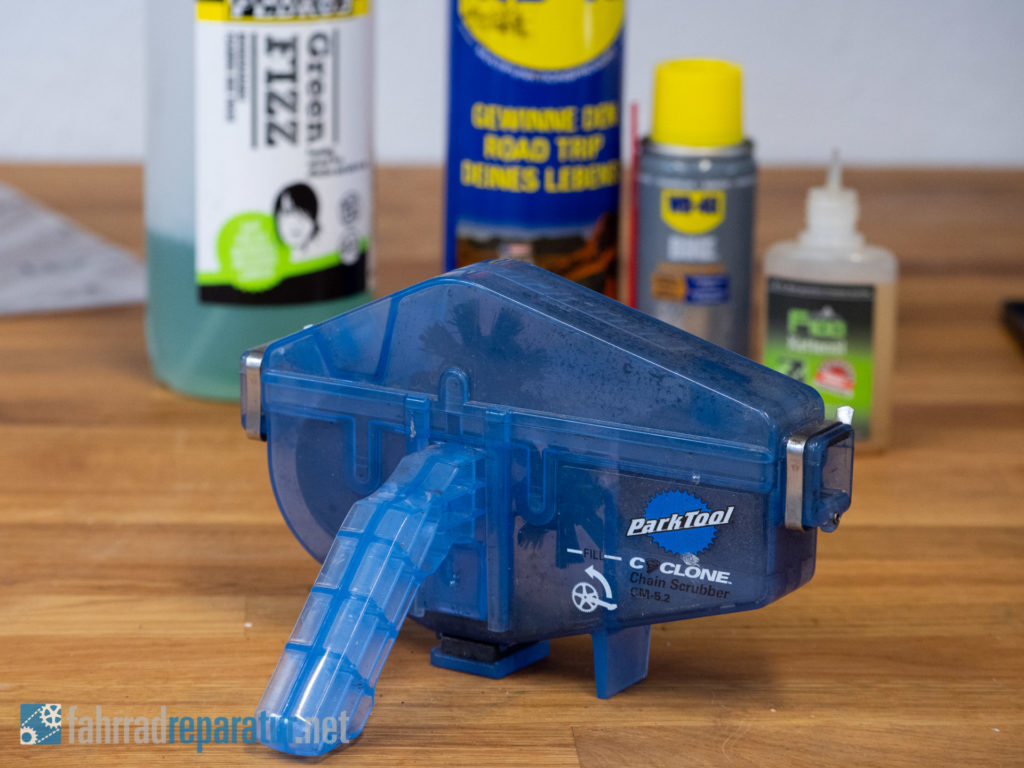
As mentioned, it is also conceivable not to use any cleaning agent and to rely purely on the mechanical removal of dirt by cleaning cloth and brush. Because a chemical cleaning agent has it in itself by the principle that it attacks the lubricating film of the bicycle chain. But this is the only way to achieve a continuous cleaning effect – because mechanical cleaning (brush, cloth) only removes the coarse dirt particles.
In any case, you should be very sparing and careful with the detergent – only a few drops on the rag at a time. We present as possible cleaning agents commercial petroleum, WD-40 and the environmentally friendly Green Fizz bike cleaner from ‘Pedro’s’, ‘Muc-Off’ or ‘F100’. Many of Pedro’s newer remedies are made entirely from environmentally friendly raw materials and are specifically designed for long-lasting use of the bike. In addition, we recommend – whether with or without chemical cleaners – to use a special chain brush.



- diverse Gefahrenhinweise (bei Verschlucken tödlich, kann Augen- und Hautreizungen hervorrufen)
- Fettlösend (löst bestehende Schmierung der Kette)
- nicht Fettlösend (greift bestehende Ölschicht der Kette nicht an)
- Verträglich mit Carbon, Gummidichtungen, Titan, Aluminium und Kunststoffe
- Fettlösend (greift bestehende Ölschicht der Kette an)
- kein Mikroplastik oder Kunststoffzusätze
- kein Mikroplastik oder Kunststoffzusätze
- kein Mikroplastik oder Kunststoffzusätze

- diverse Gefahrenhinweise (bei Verschlucken tödlich, kann Augen- und Hautreizungen hervorrufen)
- Fettlösend (löst bestehende Schmierung der Kette)
- kein Mikroplastik oder Kunststoffzusätze

- nicht Fettlösend (greift bestehende Ölschicht der Kette nicht an)
- kein Mikroplastik oder Kunststoffzusätze

- Verträglich mit Carbon, Gummidichtungen, Titan, Aluminium und Kunststoffe
- Fettlösend (greift bestehende Ölschicht der Kette an)
- kein Mikroplastik oder Kunststoffzusätze
Letzte Aktualisierung am 2025-01-29 / Affiliate Links / Bilder von der Amazon Product Advertising API
( *: Price per liter displayed is of the date of publishing 2020-08-28)
Bicycle chain cleaning
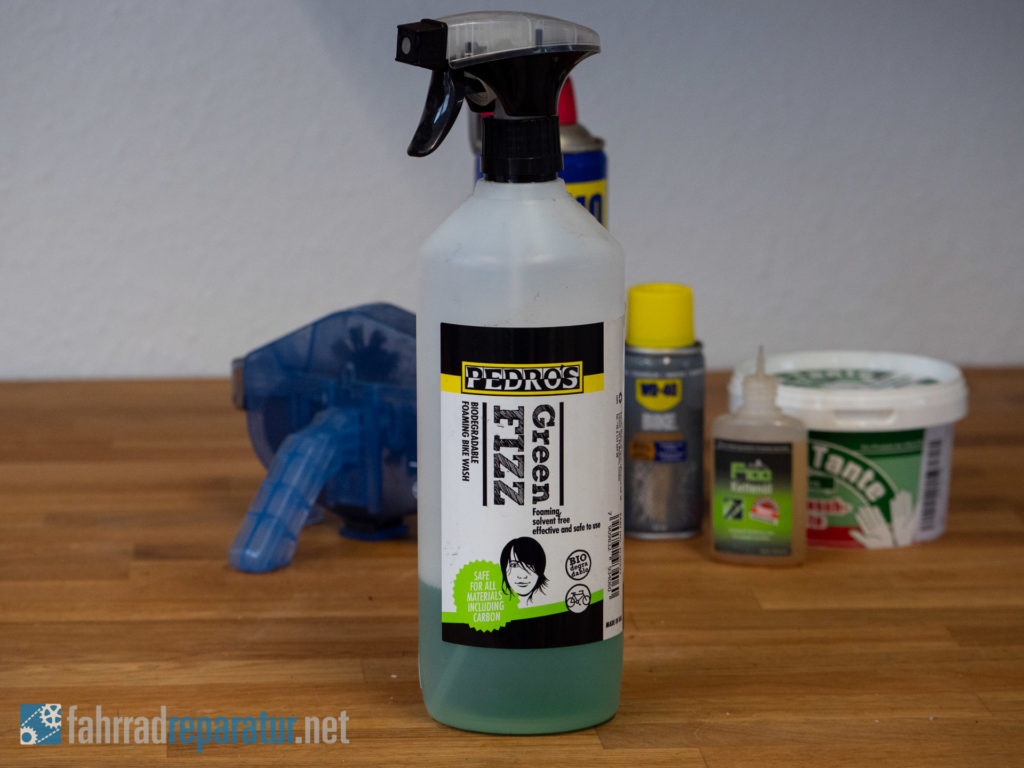
Once you have found your remedy of choice, then you can clean the chain as follows. As already mentioned at the beginning: a “deep clean” does not always have to take place. In general, it is always recommended to clean the chain briefly and only mechanically. Cleaner to be applied to the rag only. Only in the worst case, the chain should be completely submerged in the cleaner, directly processed with water and solvent.
The tool “Cyclone Chain Cleaner” from Parktool works very well for the last case. It has a mechanical and chemical component, as the tool is filled with cleaner. Therefore, it is only a choice if the chain is already heavily attacked and the inner oil film can be deliberately attacked.
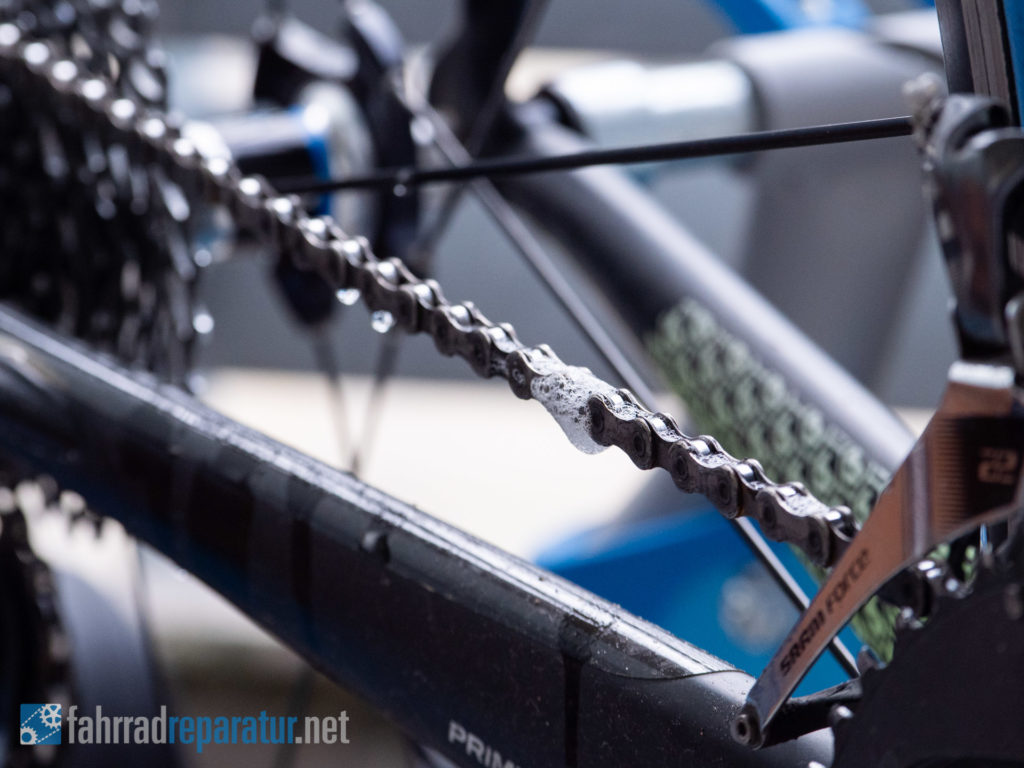
The cleaning solution (detergent diluted with water) should be applied to the chain only in the worst case. If the chain is already heavily soiled. 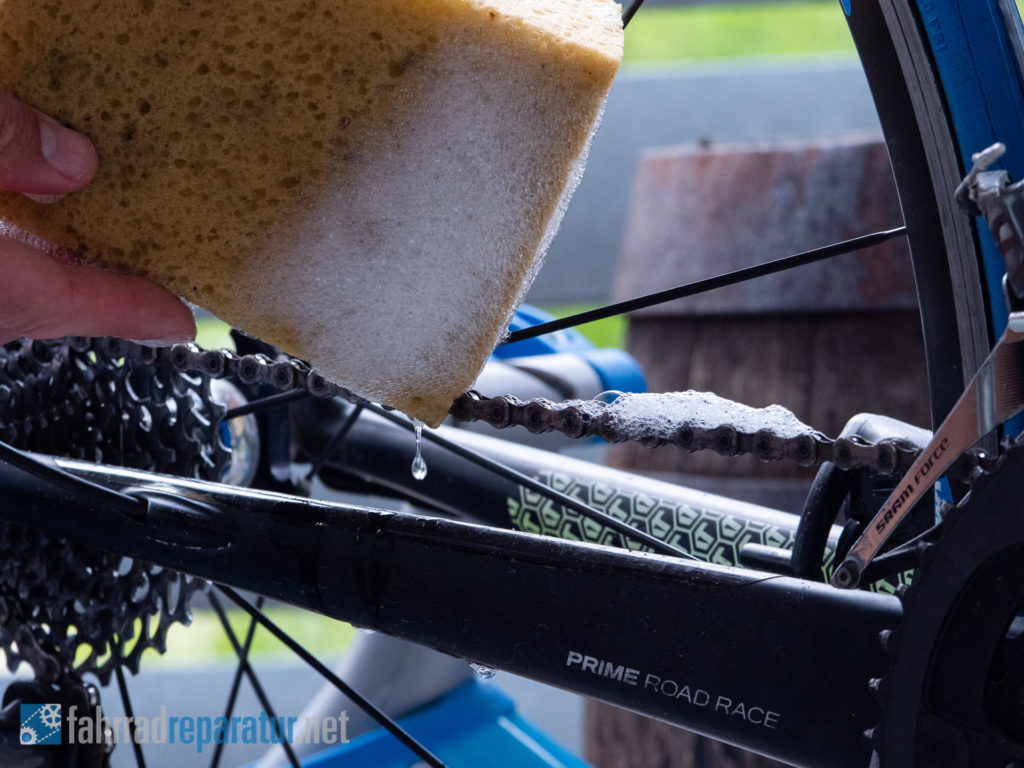
Various mechanical means are suitable for cleaning, from sponges to brushes. 
A brush can also be used without detergent, but we opt for deep cleaning in this case. 
Optionally, mechanical tools can be used as rotating brushes. The Parktool has already achieved cult status. 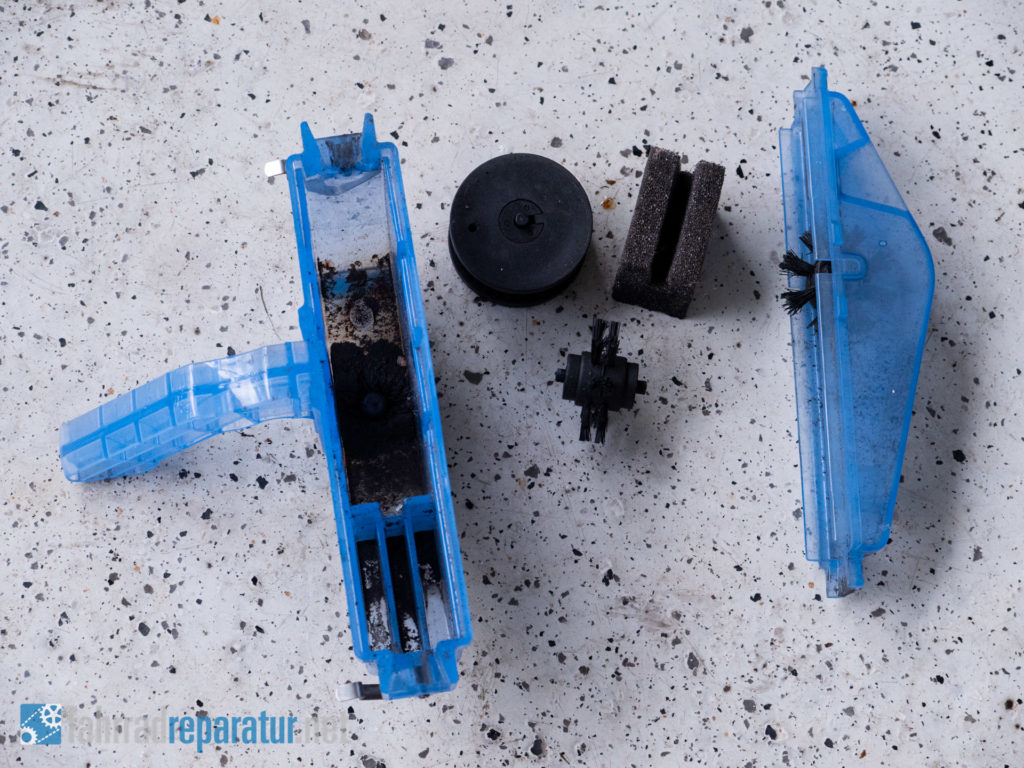
You have to hand it to the tool: It is well thought out in every detail (such as the magnetic sponge to remove metallic particles from the chain); it can be completely disassembled to replace brushes. A long service life is thus possible and extra-environmentally friendly. 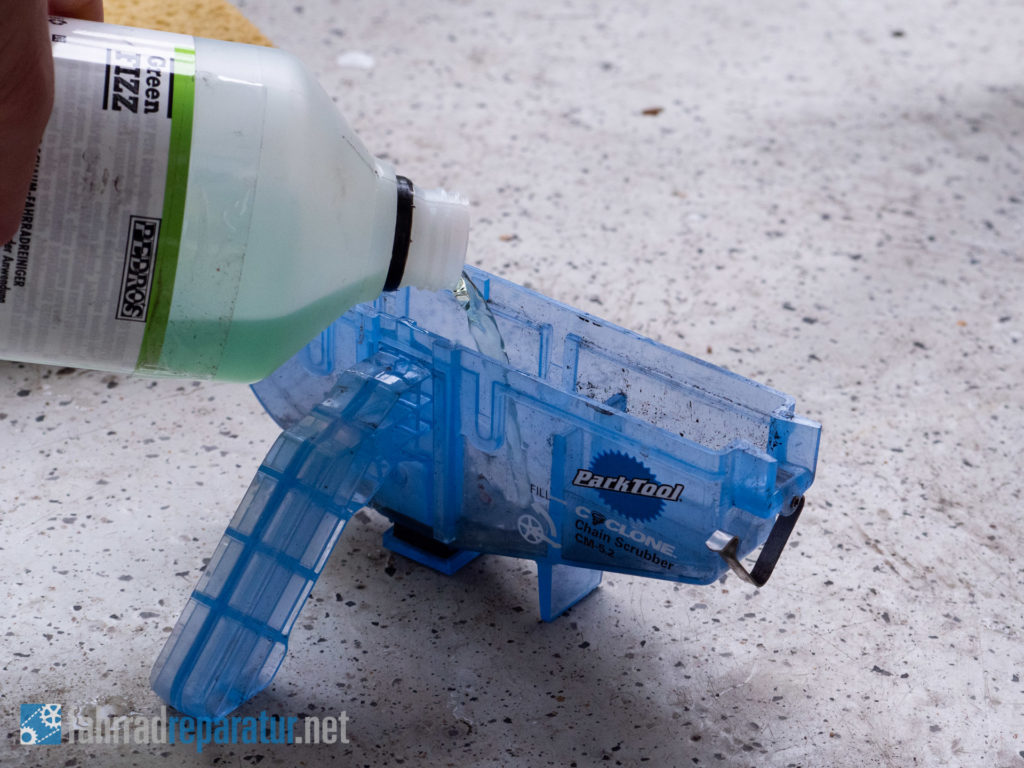
Inside is poured a mixture of water and cleaner. 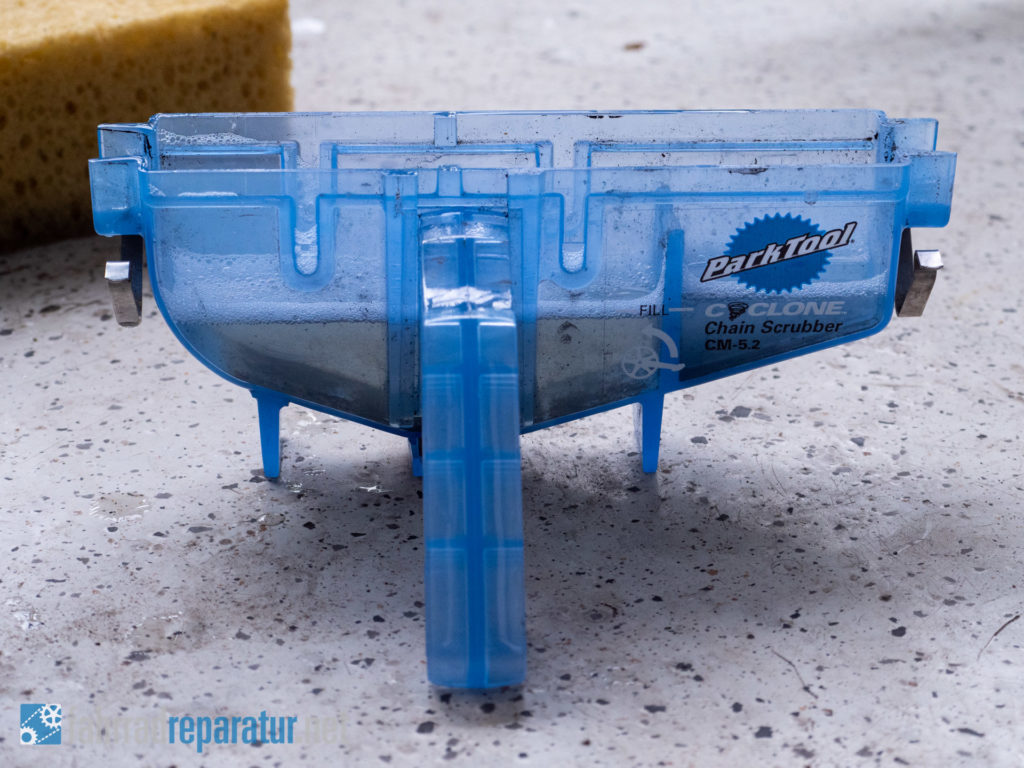
A corresponding fill line helps. 
About 50 pedal revolutions should be enough, according to Parktool. 
The result looks neat. As a rule, however, you have to go at it again with your hand and a cloth. 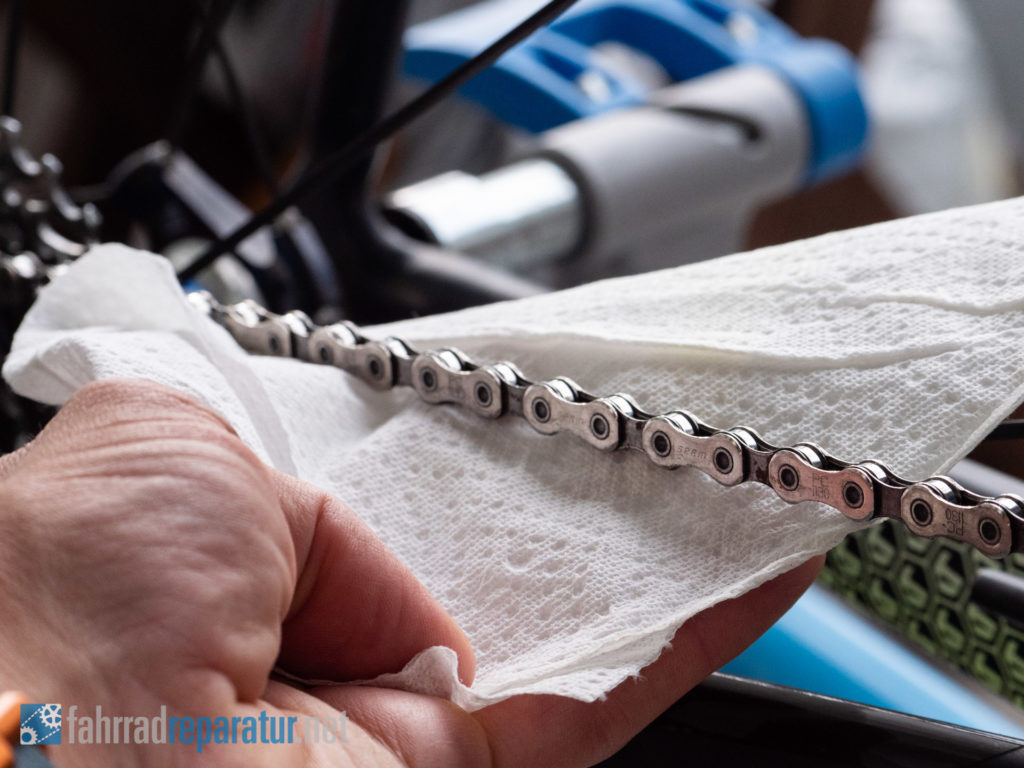
Finally, the chain must be wiped. To remove all water residues. Before lubrication, the chain must be dry. It also prevents rust from setting in again straight away.
Dust and dirt increase wear. As the most moving part on the bike, the chain is a wearing part. In order not to replace them too often (saves the environment and your wallet) it requires proper care.
Shift to the smallest sprocket at the rear first. For standard dirt, use a rag soaked in solvent or bike cleaner. The best way to do this is to take the bicycle chain with the cloth in your hand at the rear derailleur and let the chain run backwards. Do this for two or three chain turns.
For example, clean the rear spaces between the pinions with a toothbrush or a special brush. Finally, clean the front pinions on both sides. Also clean the chain itself with a brush. Scrape off stubborn dirt with a fine screwdriver.
- FARBEN : blau
Typ : Spezialwerkzeug
Letzte Aktualisierung am 2025-01-29 / Affiliate Links / Bilder von der Amazon Product Advertising API
Bicycle chain derusting
As soon as a chain is driven more often in a wet environment or in the rain, it happens faster than you think. The chain squeaks and wears rust. This does not mean that the chain is broken. With a cleaning cure you can also get a slightly rusted chain fit again.
As already mentioned in the chapter Cleaning, cleaning is a strong intervention in the important lubricating film inside the chain (between the rollers). After each cleaning, of course, must be greased, but you will never regain the original condition inside the rollers. So the cleaning itself also contributes to the fact that the total life of the chain becomes shorter. Therefore, cleaning agents should be used as late as possible.
Quick guide – derusting bicycle chain
- Try to remove the rust with a brush or rag. Then grease the chain with a few drops of oil. If the chain runs well (all links are movable, no squeaking) then you are done.
- If the chain still carries a lot of rust and squeaks even after mechanical cleaning, then you need to clean the chain thoroughly. Either with a cleaner (read tips on cleaners in the chapter above) or by dismantling the chain and soaking it in a degreasing bath and brushing it off.
- Remember to grease the cleaned chain again. More about this in the chapter on greasing the chain.
Detailed instructions as a video are also available in the GCN Tech Workshop.
Is WD-40 good for the bicycle chain?
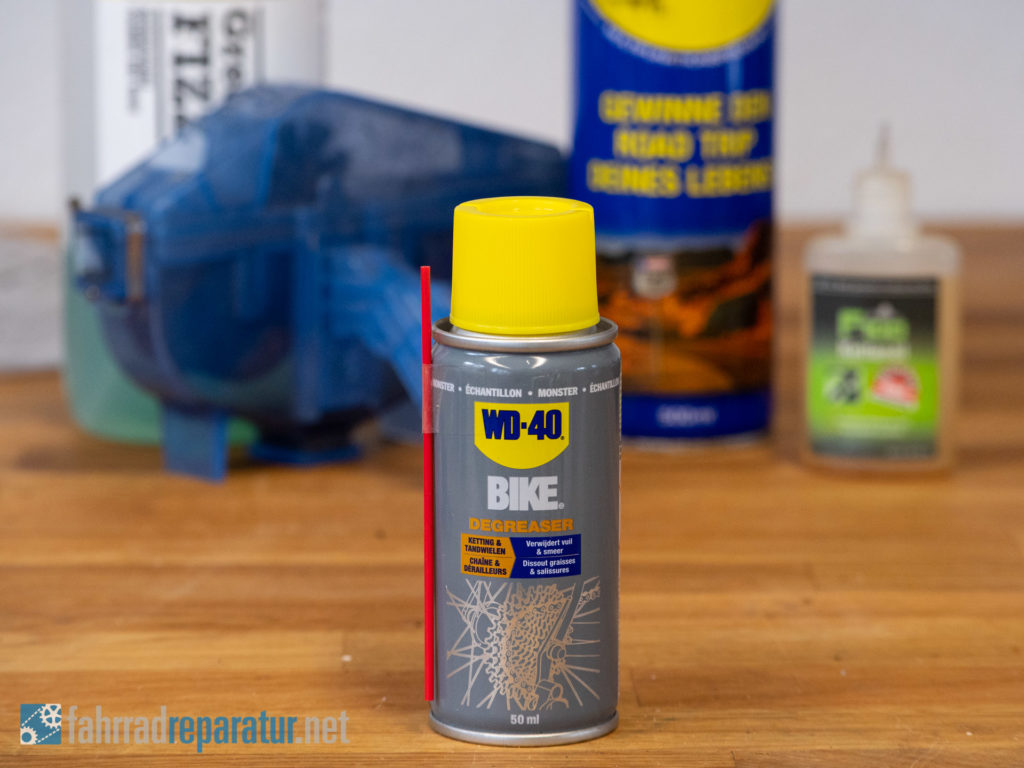
WD-40 is a very well-known and widely used all-round oil. It was developed in the 1950s for military purposes. WD-40 was intended to protect weapon parts and missiles from rust, among other things, or served as a solvent. Because of its protective and cleansing properties, it was quickly used in the home for all sorts of things (for squeaky doors or even as a cleaning agent).
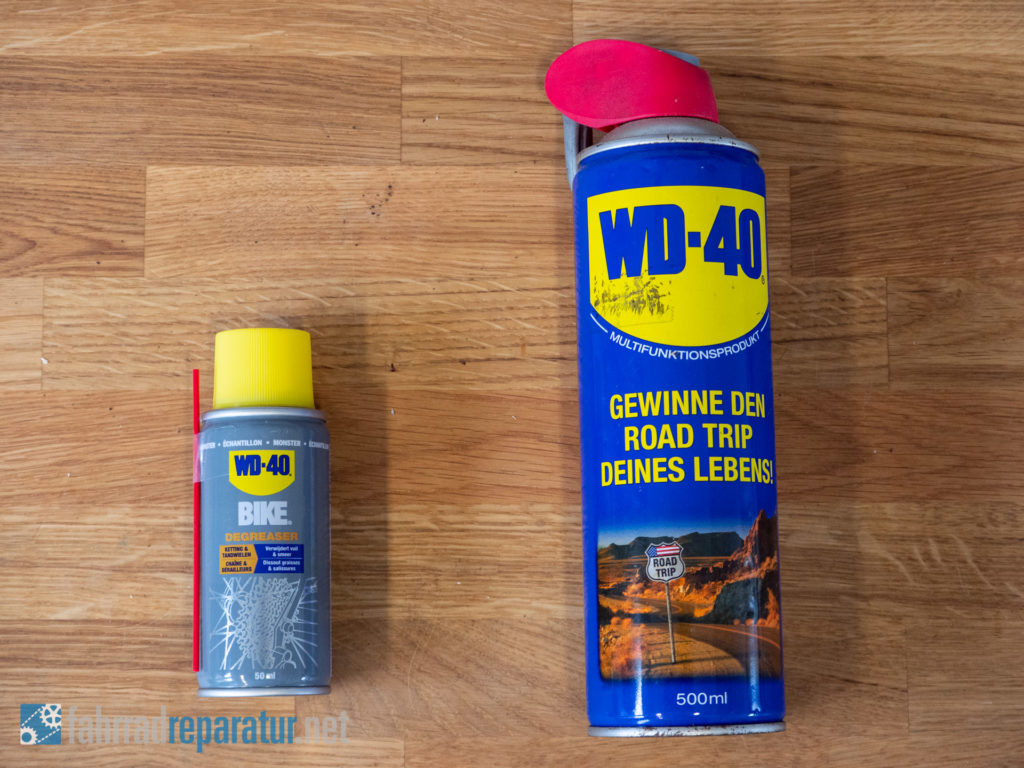
It is not suitable for lubricating the bicycle chain, because it moves too fast. WD-40 is one of the penetrating oils. This means it is more fluid than other oils and can “crawl under”. The oil cannot live out its lubricating property and thus remains without effect. Worse, the oil dries out the chain on the bike, so to speak – it attacks the thicker lubricating film of the bicycle chain and thins it. There it would be almost better not to use any bicycle oil or lubricant at all.
For this reason, we recommend you to buy normal chain oil from the bike shop. This is not expensive and also has good water repellent properties in some cases. However, the WD40 can be used to clean the bicycle chain. Because it protects against rust and degreases. Like the other detergents, you should then just use it carefully and not apply too much of it! Just like petroleum or special bike cleaners, you would destroy the internal lubricating film if you applied too much of it.
Conclusion about WD-40:
- For lubrication: NO, absolutely not.
- For frequent use: Also no, because it attacks the internal lubricating film that must be preserved.
- As deep cleaning: Possible application, but there are more environmentally friendly alternatives.
- Heavy rusting: Recommended. After that, however, the chain must also be thoroughly re-greased.
FAQ
First, you should thoroughly clean the bicycle chain. A good brush can also be used to combat rust. But effective rust control on a bicycle chain is a tricky business – because if you use too much solvent or detergent, you risk washing out the internal lubrication of the chain links, causing irreparable damage to the chain. WD-40 is most likely recommended to loosen the rust. But you should be as careful and conservative as possible with it because of the danger mentioned! And be sure to apply new chain oil afterwards!
There is no such thing as a steel that is completely stainless and at the same time able to withstand large mechanical loads and be as light as possible. However, the lubricating film of the bicycle chain should prevent oxygen from coming into contact with the steel. This prevents oxidation from taking place, which causes rust in steel. By oiling again and again, you maintain the lubricating film. Especially if the bike has been used or stood in the rain, you should re-oil – because the dirty water displaces the lubricating film and serves as a catalyst for the oxidation of the material (→ rust).
A bicycle chain wants to be regularly re-oiled! It is the lubricating film of the bicycle chain that ensures smooth running, efficient power transmission and a wear-free ride. At the latest when the bicycle chain rattles or squeaks, you should re-oil. In any case, you need to apply new oil after applying a detergent on the chain – because every detergent has it in itself to attack and dissolve the lubricating film of the chain. If the bicycle chain already jumps off or has other mechanical problems, it may already be too late – with the chain gauge you can determine whether the chain is worn.
No matter what you plan to do with your bike chain – in principle, it’s always either cleaning or lubricating. And it’s best to always lubricate after you’ve cleaned – it’s actually mandatory. Because every cleaning agent removes the lubricant of the chain – which you have to reapply with the lubrication! How you should proceed with the cleaning, you will learn here: Cleaning a bicycle chain.
Info: In this post we use affiliate links. All product mentions are independent and are made without coordination with a manufacturer, brand or any other external party – all reviews are authentic and product mentions are choice of our own opinion. For more information on ads with velonerd please refer to our advertising instructions on Velonerd.cc.

